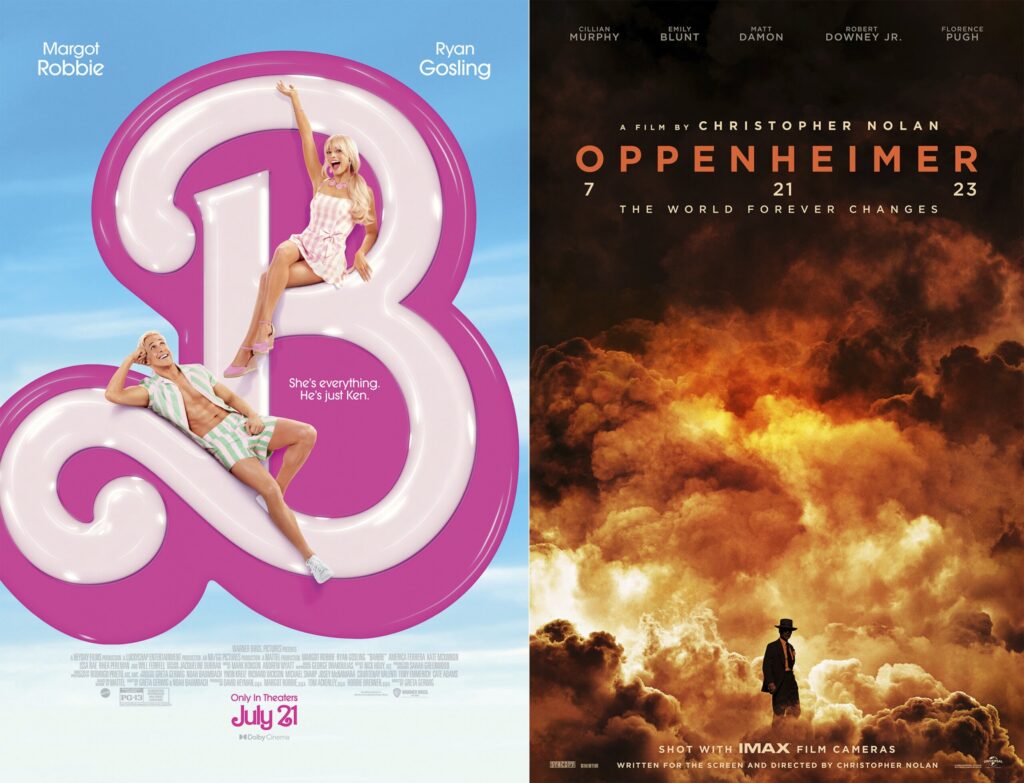
This summer gave way to the cultural phenomenon that was ‘Barbenheimer,’ which can be best described as the seemingly bizarre comparison between two feature films, Barbie and Oppenheimer. Both of these films were released on the same day in July, and many expected them to be the two best films of 2023. On the surface, Barbie and Oppenheimer could not be more different from one another, Barbie being a comedic film about children’s toys finding a way to enter the real world and Oppenheimer being a drama about the man behind the creation of the atomic bomb. When creating this exhibit, we wanted to find common ground between these two films through textual evidence within our collection here in the University of Richmond’s Galvin Rare Books Room and show that perhaps within the American experience, ‘Barbenheimer’ is not such a bizarre concept.
When selecting books for the Barbie portion of the exhibit, we aimed to have a blend of Mattel produced items as well as philosophical discussions on how Barbie has affected society and where exactly the toy originated from. Our 1964 edition of Barbie’s Easy as Pie Cookbook published by Mattel is without a doubt a gem of this exhibit. In addition to the cookbook and a Barbie doll herself, we’ve featured two more modern books that go further into detail on not only who created Barbie, in Barbie and Ruth, but also how the concept of Barbie as an ideal woman with the power to pursue anything she dreamed might have consequences on our society, in The Good, the Bad, and the Barbie. These three books offer a glimpse into the philosophy behind Barbie directed by Greta Gerwig and starring Margot Robbie as Barbie and Ryan Gosling as Ken. The film is very introspective despite being a comedy, and it shows how Mattel has constructed a seemingly perfect image of Barbie that might unintentionally strike questions of living a purposeful life and dealing with the consequences of having human flaws. Mattel’s Barbie’s Easy as Pie Cookbook falls in line with this image of easy-going perfection, and our other two book selections begin to peel back the curtain in many of the same ways that Gerwig’s film does.
The Galvin Rare Books room did have quite a few illuminating works when we began to put together the Oppenheimer portion of the exhibit. The film, directed by Christopher Nolan and starring Cillian Murphy, highlights the life of Dr. Robert J. Oppenheimer and his work on the Manhattan Project, which produced the uranium and plutonium atomic bombs. It also showcases the aftermath of the project and how Dr. Oppenheimer went on to push against the production of the hydrogen bombs, expressing concern for the morality of killing hundreds of thousands of people once again. We wanted to not only feature Dr. Oppenheimer’s work, but to showcase the lasting effects of the Manhattan Project and American perspectives on nuclear warfare. The two books that are particularly fascinating are Nobody Wants A Nuclear War and Hearings Regarding Communist Infiltration of Radiation Laboratory and Atomic Bomb Project at UC Berkley. Nobody Wants A Nuclear War is a children’s picture book written in 1986 describing how frightened children were that because of the constant threats between the United States and the USSR, another atomic bomb would be dropped. Instead of the war being on foreign ground, the children were scared it would be where they lived. This book is particularly striking in relation to the mental consequences that nuclear warfare had on generations to come, even forty years after the atomic bombs were dropped on Nagasaki and Hiroshima, and it shows how the effects of war become more real when they threaten you instead of your enemy. The second work is the transcript of hearings in which a government appointed investigation interviews many important figures who worked on the atomic bomb projects throughout World War II, including General Groves who spearheaded the military portion of the project as well as Dr. Frank Oppenheimer, Dr. Robert J. Oppenheimer’s brother. The interviews were conducted in order to investigate who leaked top-secret information to the USSR or to communist parties within the United States. These two rare items in our collection highlight the long-lasting effects of nuclear warfare in the mind of Americans, and they express a feeling of mistrust and doubt over the decisions that the government had made in the past.
The Barbenheimer exhibit aims to foster thorough questioning of the American experience in many of the same ways that Barbie and Oppenheimer aim to do as well. As you peruse the exhibit, consider whether or not these films and books of the cultural phenomenon of ‘Barbenheimer’ seem all that different. In both of our Barbie and Oppenheimer themes, it is clear that an existential doubt emerges: what is the purpose of consumption and creation? What consequences do my actions and my life bring? If I aim to bring good to the world, will good come after me?
List of items displayed:
- Barbie’s Easy as Pie Cookbook PZ10.L39 Ba 1964
- The Good, the Bad, and the Barbie NK4894.3.B37 S76 2010
- Barbie and Ruth NK4894.2.H324 G47 2009
- Robert Oppenheimer QC16 .O62 M66 2013
- Hearings Regarding Shipment of Atomic Material to the Soviet Union during World War II E743.5 .U4 1950
- Nobody Wants a Nuclear War PZ7.V67 No 1986 p. “Sometimes i’m scared”
- Three Poems for Now PS3523.I648 T4 1972
- Hearings Regarding Communist Infiltration of Radiation Laboratory and Atomic Bomb Project at UC Berkeley E743.5 .U64 1949
- Three Lectures on Atomic Physics QC173 .S53 1926
